| |
Klepper Sailing
by Tord Eriksson
Today we, my wife and I, sailed our Klepper Aerius
II Expedition. Nothing special you say, but for my wife it was
her very first trip in any kind of sailing vessel, big or small,
and for me it was a return to what I did in my late teens, even
if the boats then were twice as long and possibly 100 times
heavier!
Pretty early we decided that an outrigger of some
kind would be helpful, and having read Dal Stanley's account
of experiments with various rigs and floats we knew we wanted
a single float of some kind, sticking out to the starboard side,
as we also have bought a tiny four-stroke outboard that prefer
that side (so we'll keep the float on for powered trips).
By the way, here's Dal's URL:
https://dalstanley.tripod.com/folbot.htm
Having studied various types of inflatable things,
that possibly could be used as an outrigger, I suddenly came
to think of a dormant model project of mine: A flying boat made
out of EPP (the wings would come from a Dave's Aircraft Works
sailplane, as they already are made of EPP, this wonder material
that can stand almost any mishandling and then just bounces
back to original shape).
Deep down in the cellar I found the flying boat
hull, a little dusty and devoid of any covering or other nice
details, but it would do for a test. A 20 x 20 mm aluminium
tube (6063) would do as the arm that the outrigger attches to
and the arm itself I clamped to the leeboard crossbar with Klepper-style
J-clamps. The flying boat hull I attached to the tube with a
piece of string - that's pretty much it!
Took a while to rig the Klepper, but eventually
we were ready - my wife in the rear as helmsman and me up front
pulling all the ropes :-)!
We had slept late - I arrived home after midnight
Friday evening after a 10 hour day driving a non-airconditioned
bus - so we were eventually ready to sail about 2 pm. Can't
say the Klepper mast impressed me much - very wobbly unless
you really tighten the stays, and the stays get in the way when
you sail down-wind - not really the best design I've seen. I
had replaced the original stays with kevlar lines - dyneema
is probably even better - and added a kicking block to stretch
the sail better. I also added lines so I could lower both the
jib and the main while under way, from both the rear and the
front seat.
My wife used the pedals to steer and I managed
the sails - and until we started to make good speed my wife
wasn't that impressed, but she quickly got bitten by the sailing
bug! So now she awaits next chance to battle with the wind.
Sadly I forgot to turn the GPS on, but I'm pretty
certain that we went supersonic at times :-)!
After a really rewarding afternoon at our favourite
lake,
Tord S Eriksson
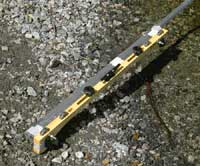 1)
We're tyros when it comes to sailing, so we decided an
outrigger (aka stabilisating float) would be a good idea:
Our stabilisation float would need to be attached to the
leeboard crossbar, so we got an aluminium square tube
and clamped it to the crossbar - the neat trick is that
the tube is held to the crossbar with J-clamps, the type
Klepper uses to hold the crossbar to the railing - a perfect
fit. I had to use ordinary nuts instead of the knurled
nuts, for space reasons. So now we have a 20 x 20 mm square
tube attached to the crossbar - now we just needed a float:-)! 1)
We're tyros when it comes to sailing, so we decided an
outrigger (aka stabilisating float) would be a good idea:
Our stabilisation float would need to be attached to the
leeboard crossbar, so we got an aluminium square tube
and clamped it to the crossbar - the neat trick is that
the tube is held to the crossbar with J-clamps, the type
Klepper uses to hold the crossbar to the railing - a perfect
fit. I had to use ordinary nuts instead of the knurled
nuts, for space reasons. So now we have a 20 x 20 mm square
tube attached to the crossbar - now we just needed a float:-)! |
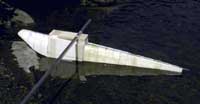 2)
Has some problems finding a suitable float - tried fenders,
et cetera - till I came to think of a dormant modelling
project: A flying boat made out of EPP, expanded poly-propylene!
Naturally that would do quite well, I thought. A piece of
plywood on top of the wing saddle, and a string to tie the
fuselage to the aluminium tube should do - if it works I'll
add covering and other niceities! 2)
Has some problems finding a suitable float - tried fenders,
et cetera - till I came to think of a dormant modelling
project: A flying boat made out of EPP, expanded poly-propylene!
Naturally that would do quite well, I thought. A piece of
plywood on top of the wing saddle, and a string to tie the
fuselage to the aluminium tube should do - if it works I'll
add covering and other niceities! |
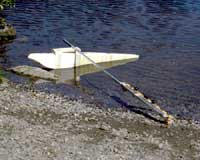 |
3) Here you see the flying boat fuselage
attached to the tube and the crossbar, just the leeboards
missing - and the Klepper! The test tube is bit too long,
and not suiatble to seawater, but we'll get a better one
soon! As there are no holes drilled in the tube it is much
stronger than one with holes! |
| 4) Here is our Klepper with the sails
raised for the very first time, and the float attached (not
visble) |
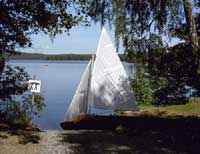 |
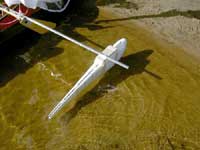 |
5) After a few hours of sailing back and
forth across a lake the verdict was out:
The pole was indeed slightly too long (as we had guessed),
otherwise everything worked as a charm. |
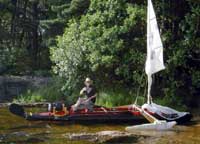 6)
So we took a rest, lashed the main to the mast and lowered
the jib. My wife has never, ever, before been aboard a
sailing vessel of any kind, while my last trip in a sailing
boat was over three decades ago! But my wife was very,
very pleased and loved it when we raced along the lake
and managed the steering quite well after getting used
to the fact that the boat leaned a bit. Being busy steering
she had no time to get scared! We might, later, add a
second UNSTAYED mast and move the main to the rear mast,
and possibly, add a small jib inbetween the two masts.
But as it is it is pretty darn nice :-)! 6)
So we took a rest, lashed the main to the mast and lowered
the jib. My wife has never, ever, before been aboard a
sailing vessel of any kind, while my last trip in a sailing
boat was over three decades ago! But my wife was very,
very pleased and loved it when we raced along the lake
and managed the steering quite well after getting used
to the fact that the boat leaned a bit. Being busy steering
she had no time to get scared! We might, later, add a
second UNSTAYED mast and move the main to the rear mast,
and possibly, add a small jib inbetween the two masts.
But as it is it is pretty darn nice :-)!
The Klepper mast is not very practical as it is in three
pieces (a bit wobbly, unless you tighten the stays really
hard). And these stays really get in the way when sailing
downwind! |
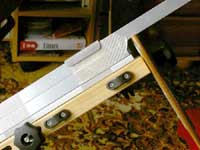 |
7) This shows the J-clamp gripping the
tubes - the inner two tubes are there to make it possible
to attach and turn the leeboard into its up position. The
tubes are taped together with strapping tape - this is not
100% UV-proof, but cost very little to replace |
| 8) The same J-clamp as before. but seen
from the bottom. |
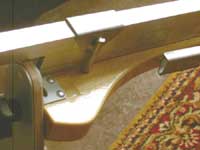 |
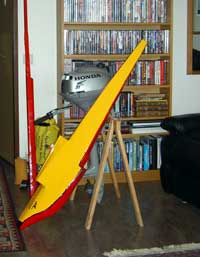 9)
To turn your kayak into a powered one you need an outboard,
in this case the fourstroke Honda BF 2, short rig version,
as it is about the right power and a fuel miser. Then you
need, to make it easy, an outrigger (here a converted model
aircraft hull made of EPP, covered with strapping tape and
yellow Oracover) and an arm for the outrigger - in this
case an aluminium square tube (20x20x2 mm) of 6063 T6 quality,
with a 30 x 4 mm spar on top, for the inner 40% of the tube's
length, taped together with 3M strapping tape and finally
covered with red model airplane film, of unknown origin. 9)
To turn your kayak into a powered one you need an outboard,
in this case the fourstroke Honda BF 2, short rig version,
as it is about the right power and a fuel miser. Then you
need, to make it easy, an outrigger (here a converted model
aircraft hull made of EPP, covered with strapping tape and
yellow Oracover) and an arm for the outrigger - in this
case an aluminium square tube (20x20x2 mm) of 6063 T6 quality,
with a 30 x 4 mm spar on top, for the inner 40% of the tube's
length, taped together with 3M strapping tape and finally
covered with red model airplane film, of unknown origin. |
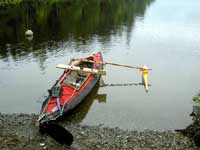 10)
You have to attach the outboard to the kayak some way, so
we used a piece of a leftover table top, very sturdy, and
added a aluminium angle (80 x 80 x 6 mm) to its starboard
end. The aluminium angle is padded on one side with a piece
of soft plywood, to give the outboard better grip. 10)
You have to attach the outboard to the kayak some way, so
we used a piece of a leftover table top, very sturdy, and
added a aluminium angle (80 x 80 x 6 mm) to its starboard
end. The aluminium angle is padded on one side with a piece
of soft plywood, to give the outboard better grip.
The board is held in place by two Klepper J-screws, and
supported in the centre by a aluminium tube (10 x 20 x
1.5 mm) to offload the frame and the cockpit coaming a
bit. The tube is bolted to the # 4 frame. The outrigger
is tied to the arm, as it seems to need a certain degree
of movement.
The blue hose visible belongs to the bilge pump, while
the white and blue rope was an experiment with rope assisted
steering - not successful - so now we'll try a tiller
instead :-)! |
 11)
Closeup: The compass was in the way, so now it sits on the
bottom of the board instead. Eventually the knurled nuts
to the J-screws will be recessed, but this was an experiment,
nothing more! 11)
Closeup: The compass was in the way, so now it sits on the
bottom of the board instead. Eventually the knurled nuts
to the J-screws will be recessed, but this was an experiment,
nothing more! |
| 12) A bit dark picture, but then it was
a very dark and rainy day - except for that it looks very
idyllic, don't you agree?! |
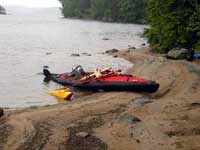 |
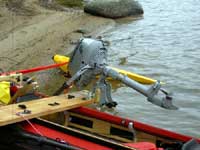 13)
The compass has been removed, as has the rope steering.
The vertical line along the left side of the picture is
a result of a problem with GIMP (should have booted XP and
Photoshop, but didn't have the time, nor the urge!). 13)
The compass has been removed, as has the rope steering.
The vertical line along the left side of the picture is
a result of a problem with GIMP (should have booted XP and
Photoshop, but didn't have the time, nor the urge!). |
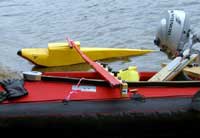 15)
The outrigger performed flawlessly, as usual, The arm looks
a bit bent, but that is an visual effect of the reinforcing
spar being slightly non-aligned with the square tube. J-screws
aplenty, both holding the leeboard attachment to the coaming
and holding the arm to the leeboard attachment. Worked quite
well having the leeboards attached, but didn't improve things
either, so we eventually took them off (seen sticking up
from the cockpit). 15)
The outrigger performed flawlessly, as usual, The arm looks
a bit bent, but that is an visual effect of the reinforcing
spar being slightly non-aligned with the square tube. J-screws
aplenty, both holding the leeboard attachment to the coaming
and holding the arm to the leeboard attachment. Worked quite
well having the leeboards attached, but didn't improve things
either, so we eventually took them off (seen sticking up
from the cockpit). |
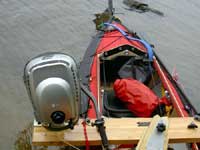 16)
View rearward: See that the outboard is at an angle, just
that much is needed for the boat to run straight with neutral
rudder at quarter throttle - at higher setting less is needed.
Really not a lot of offset. Again the bilge pump hose is
clearly visible, as are the details of the hiking board. 16)
View rearward: See that the outboard is at an angle, just
that much is needed for the boat to run straight with neutral
rudder at quarter throttle - at higher setting less is needed.
Really not a lot of offset. Again the bilge pump hose is
clearly visible, as are the details of the hiking board. |

|
|
|
| Featuring
|
| |
Plans
 |
| |
| |
| |
|
|
|
Books

|
| |
Magazines

|
| |
| |
Chandlery

|
| |
|
|
|
| |
|
|
|
| |
|
|
|
|
| |
Sail
Loft

|
|
|
|
|
|
|
CDs
 |
| |
Wearables
 |
| |
| |
| |
Fun
Stuff

|
| |
|
| d |
|

